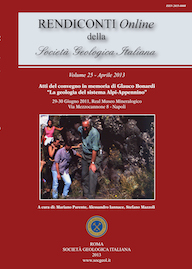
Some factors that can explain the particular complexity of the middle-southern Appennine chain
Italo Sgrosso (*)
(*) Dipartimento di Scienze della Terra, Università di Napoli Federico II, Largo San Marcellino 10, 80138, Napoli, Italia.
DOI: https://doi.org/10.3301/ROL.2013.09
Volume: 25/2013
Pages: 95-105
Abstract
The interpretation of the central-southern sector of the Apennine mountain belt has always been considered as complex and difficult; this is why the literature shows the coexistence of several different structural and paleogeographic models. In the present work some factors are described, which should explain the structural complexity and the coexistence in the literature of such contrasting interpretative models. These factors are the following: a) the presence of several out of sequence thrusts, backthrusts and strike-slip faults; b) the occurrence of repeated tectonic events related to gravity; c) the absence of complete paleogeographic domains in the chain; d) “misleading evidences”; e) difficulty in the choice of the data presented in the literature; f) presence of a rather complex paleography predating deformation. Each of these factors is discussed. Specifically, since the model implying an articulated paleography is not easily accepted in the current literature, here a whole set of data and methodologies are proposed, which allow to hypothesize a Mesozoic and Tertiary paleography, previous to the tectogenesis. The most important methodology used is the study of Miocene and Pliocene deposits, which are in stratigraphic contact with the pre-tectonic substrate. This study allows to recognize a series of stratigraphic-structural units, each of them highlighting a sequence of the most relevant moments in the tectonic evolution (beginning with the flexure, with the concordant transgression in the platform domains and individuation of the foredeeps, deepening with disappearance of the platform facies, mature foredeeps with beginning of arkosic siliciclastic sedimentation, accretion of a portion of the foreland to the chain, first thrust top deposition, etc.). A similar kinematic history develops in different times for each paleogeographic domain, being more ancient in the most internal domains, and more recent in the external ones. By considering the reciprocal position of the platform facies, of basin and basin transition, and by positioning every kinematic unit in ascending order of the beginning age of the arkosic siliciclastic sedimentation, a quite articulated paleogeographic model is obtained, composed by a whole of six carbonate platforms separated by basins. As a corollary, the possible existence of two distinct tectonic phases is emphaisized. The first must be related to the opening of the Alboran sea, the other to the opening of the Tyrrhenian Sea; probably each of them are characterized by a different subduction angle.
Keywords
structural complexity, tectonic-sedimentary evolution, paleogeographic reconstructions, central-southern Apennines
Get Full Text